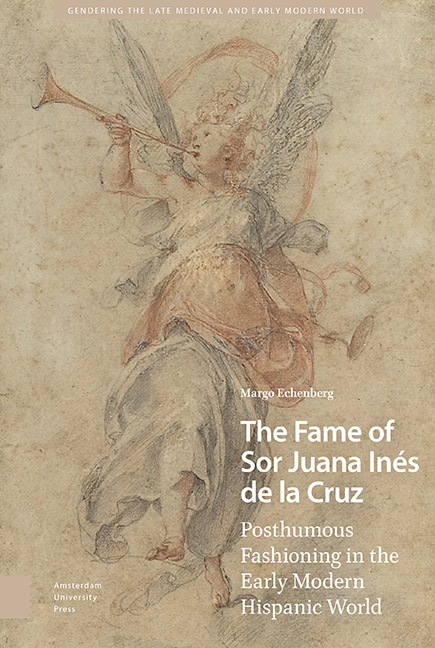Book contents
- Frontmatter
- Table of Contents
- A Note on the Text
- Abbreviations
- Acknowledgments
- Introduction: Negotiating Rumor and Fame: Sor Juana Inés de la Cruz’s Posthumous Fama
- 1 The Fama: A Posthumous Imaging and Imagining of Sor Juana
- 2 Soaring above the Rest: Sor Juana as “Sacred Phoenix” and the Fama as Moral Exhortation
- 3 Light from the New World: Posthumous Praise for an American Mind
- 4 With “Quills of Ink” and “Wings of Fragile Paper”: Sor Juana Responds to Her Public Image
- Afterword (Or Why Think of the Fama as a Success If It Fails on Almost All Fronts?)
- Appendix A Contents of the Fama y obras pósthumas (1700)
- Appendix B Sections of the Fama y obras pósthumas (1700)
- Bibliography of Works Cited
- Index
Introduction: Negotiating Rumor and Fame: Sor Juana Inés de la Cruz’s Posthumous Fama
Published online by Cambridge University Press: 18 November 2023
- Frontmatter
- Table of Contents
- A Note on the Text
- Abbreviations
- Acknowledgments
- Introduction: Negotiating Rumor and Fame: Sor Juana Inés de la Cruz’s Posthumous Fama
- 1 The Fama: A Posthumous Imaging and Imagining of Sor Juana
- 2 Soaring above the Rest: Sor Juana as “Sacred Phoenix” and the Fama as Moral Exhortation
- 3 Light from the New World: Posthumous Praise for an American Mind
- 4 With “Quills of Ink” and “Wings of Fragile Paper”: Sor Juana Responds to Her Public Image
- Afterword (Or Why Think of the Fama as a Success If It Fails on Almost All Fronts?)
- Appendix A Contents of the Fama y obras pósthumas (1700)
- Appendix B Sections of the Fama y obras pósthumas (1700)
- Bibliography of Works Cited
- Index
Summary
Abstract: This chapter examines the conditions and qualities of Sor Juana that made her a celebrity in her time and warranted her posthumous fame in a transatlantic tribute published in Spain. Instead of the limits of existing models of renown transforming to accommodate a colonial woman author, she is reconciled into conventional notions of fame. The three fictions of Sor Juana that emerge most clearly in her posthumous tome are that of the saintly exemplar, the Tenth Muse of New Spain, and the New World marvel. All three help bridge the gap from celebrity to being worthy of enduring fame and can be traded in the male literary marketplace. Within the framework of Celebrity Studies, I examine both Sor Juana’s role as agent of her own celebrity and the negotiations of her panegyrists.
Keywords: Sor Juana Inés de la Cruz; Fama y obras póstumas; posthumous fame; Celebrity Studies; Hispanic Baroque; seventeenth-century women writers
The third and final volume of Sor Juana Inés de la Cruz’s works published in her time (if not her lifetime), appeared posthumously in Madrid in 1700. Organized and edited in New Spain and Old, the Fama y obras pósthumas [Fame and Posthumous Works] includes writing by Sor Juana (1648–1695), the cloistered Hieronymite nun known as New Spain’s “Tenth Muse,” dozens of elegies written upon her death by Spanish and Mexican peers and a voluminous paratext in the way of licenses, a frontispiece, a vita and two prologues. Alone in being the third volume of work published by a New World criolla nun in Spain, the complex baroque volume is also her fama póstuma, a tribute to her posthumous fame, written and printed at a time in which fame was off limits to women and literary posthumous fame (a male affair) did not assure glory. As Ann Rosalind Jones has shown, although the winged figure of allegorical Renaissance iconography that personified Fame was a woman, seventeenth-century women were excluded from her realm (1986, 74). And posthumous literary fame could not be uncoupled from the author’s moral exemplarity until well into the eighteenth century (Goodman 549).
- Type
- Chapter
- Information
- The Fame of Sor Juana Inés de la CruzPosthumous Fashioning in the Early Modern Hispanic World, pp. 13 - 54Publisher: Amsterdam University PressPrint publication year: 2023



